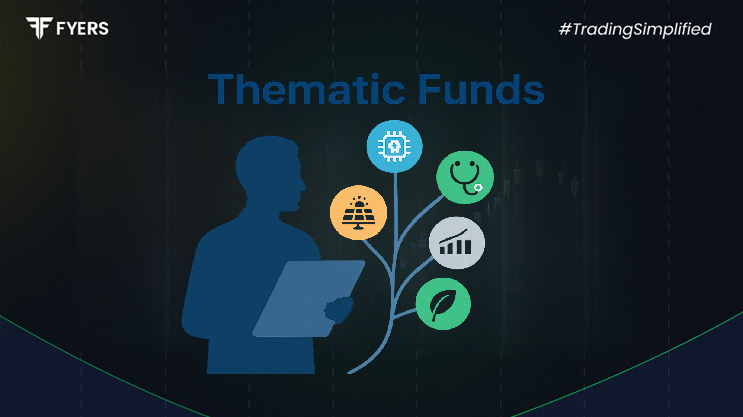

 17 Sep, 2025
17 Sep, 2025
 4 mins read
4 mins read

Mutual funds have evolved far beyond traditional equity and debt categories. Today, investors can target specific ideas, themes, or sectors through thematic funds. These funds allow individuals to participate in long-term investment opportunities built around particular economic, social, or industry-based trends.
In this article, we will explore what thematic funds are, how they differ from sectoral funds, the types available in India, and their advantages, risks, and examples.
Thematic funds are a category of mutual funds that invest in stocks connected to a particular theme, idea, or trend. Instead of focusing on the entire market, they concentrate on companies benefiting from specific structural changes in the economy.
For example:
A thematic mutual fund focusing on renewable energy may invest in solar, wind, and electric vehicle companies.
A consumption-driven thematic fund might focus on FMCG, retail, and lifestyle companies.
This approach enables investors to capitalise on growth opportunities arising from long-term shifts such as digitisation, infrastructure development, or sustainability.
Although thematic funds and sectoral funds often appear similar, there is a crucial difference:
|
Feature |
Thematic Funds |
Sectoral Funds |
|---|---|---|
|
Investment Scope |
Covers multiple sectors linked by a theme (e.g., digital economy: IT, fintech, telecom) |
Invests only in one specific sector (e.g., banking or pharma) |
|
Diversification |
Broader, as it spreads across sectors tied to a theme |
Narrow, limited to one sector |
|
Risk Level |
Moderate to high, depending on theme’s scope |
Higher, as it depends solely on one sector’s performance |
In short, thematic mutual funds are broader than sectoral funds, but still carry concentrated risks compared to diversified equity funds.
Indian investors can choose from various thematic mutual fund schemes, each aligned with a different economic idea:
Consumption-based Funds – Focus on FMCG, retail, automobiles, and discretionary spending.
Infrastructure Funds – Invest in construction, power, transport, and allied sectors.
Technology & Innovation Funds – Cover IT, fintech, e-commerce, and communication.
Environmental & ESG Funds – Invest in companies promoting renewable energy, sustainability, and governance practices.
International Thematic Funds – Provide exposure to global megatrends such as artificial intelligence, healthcare, or clean energy.
These categories allow investors to align their portfolios with personal convictions or macroeconomic growth stories.
Investing in thematic mutual funds offers several benefits:
Targeted Exposure – Investors can participate in specific growth opportunities.
Long-Term Potential – Themes such as digitisation or green energy may deliver sustainable growth.
Diversification Beyond Traditional Funds – Provides exposure across multiple sectors tied to one theme.
Flexibility – Investors can select themes matching their beliefs, such as technology-driven growth or climate-conscious investing.
Higher Return Possibility – If the chosen theme outperforms, returns can be significantly higher compared to broad market funds.
Despite their advantages, thematic mutual funds come with certain risks:
Concentration Risk – Investment is tied to a single theme, making it vulnerable to changes in that area.
Market Cyclicality – Some themes may perform well only in certain phases of the economic cycle.
High Volatility – Prices may fluctuate more than diversified equity funds.
Limited Track Record – Many thematic funds are relatively new, with shorter performance histories.
Therefore, thematic funds are better suited for investors with a moderate to high risk appetite and a long-term horizon.
Some popular thematic and sectoral thematic mutual fund schemes in India include:
SBI Consumption Opportunities Fund (Consumption theme)
Nippon India Power & Infrastructure Fund (Infrastructure theme)
ICICI Prudential Technology Fund (Technology theme)
Mirae Asset ESG Sector Leaders Fund (Sustainability theme)
Motilal Oswal Nasdaq 100 ETF Fund of Fund (International thematic fund)
These examples illustrate how investors can select themes that align with their investment outlook.
Thematic funds are suitable for:
Investors with strong conviction in specific themes.
Individuals seeking higher growth potential by betting on long-term structural changes.
Those willing to accept higher risk and volatility compared to diversified equity funds.
Investors who already have a diversified portfolio and want to allocate a portion to high-growth opportunities.
Investing in thematic mutual fund schemes is straightforward:
Research Themes – Identify themes with long-term relevance, such as technology or infrastructure.
Select a Fund – Compare performance, expense ratio, and fund manager expertise.
Investment Mode – Choose between lump sum or SIP (Systematic Investment Plan).
Track Progress – Monitor fund performance against benchmarks and economic developments impacting the theme.
Many investors prefer SIPs in thematic mutual funds to average out volatility over time.
Thematic funds offer investors a chance to participate in long-term economic shifts by focusing on specific themes like consumption, infrastructure, or sustainability. While they present exciting opportunities, they also come with higher risks due to concentration.
Investors must balance their portfolios by allocating only a portion of their investments to thematic funds, ensuring overall diversification. For those with conviction in a theme and the patience to stay invested, thematic mutual funds can be a powerful wealth-creation tool.
Thematic funds are mutual funds that invest in companies linked to a specific theme, such as technology, infrastructure, or renewable energy.
Thematic funds cover multiple sectors tied to one theme, while sectoral funds invest only in one specific sector.
Yes, they are considered higher risk than diversified funds due to their concentrated nature, but they also offer higher return potential.
The “best” depends on the investor’s theme preference and risk appetite. Popular options include SBI Consumption Opportunities Fund, ICICI Prudential Technology Fund, and Nippon India Infrastructure Fund.
Calculate your Net P&L after deducting all the charges like Tax, Brokerage, etc.
Find your required margin.
Calculate the average price you paid for a stock and determine your total cost.
Estimate your investment growth. Calculate potential returns on one-time investments.
Forecast your investment returns. Understand potential growth with regular contributions.